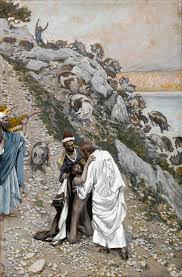JC & the Law: the pigs of Gedarenes … (12/12/18)
This story (shared in Matthew 8:28-34, Mark 5:1-20, & Luke 8:26-39)1, set supposedly in “the country of the Gedarenes”2 (Matthew 8:28a), shows Jesus confronting a demon-possessed man (in Matthew‘s case, two possessed men) and then casting said demons into the bodies of a nearby herd of pigs, who then rushed down into the sea and perished. In all three tellings the neighboring townspeople, upon seeing that the demons had been cast out and that the man had returned to mental health, were deathly afraid and – oddly enough – begged Jesus to leave their township. Indeed, just as this is the only time in the Gospels where we see Jesus encouraging a benefactor of his healing ways to share the good news thereof with others3, so too this is the only time in the entire New Testament where we see the benefactors of those wonders be openly ungrateful for the same. After all, Matthew makes it clear enough that the demoniac was “so fierce that no one could pass that way” (Matthew 8:28b), so why would the locals be so unkind to Jesus after he exorcised the same? Well, as it turns out there is a historical explanation available for this conundrum; an explanation that once again shows Jesus to be a bold reformer of the Law as it was being practiced in his day. For as it turns out, Gerasenes – the hub of social influence for that entire region – happened to be populated by Jews who refused to eat the flesh of pigs; Jews who were simultaneously raising swine to sell to pig-eating Gentiles in the neighboring Decapolis (where the freshly cleansed man was sent in Mark 5:20). In truth, as the rest of the Gospels clearly show, Jesus loathed hypocrisy regardless of who was doing the committing thereof – especially hypocrisy being committed by the supposedly pious in order to obtain material wealth (see Matthew 6:24‘s “You cannot serve God and wealth”, Matthew 15:8‘s“These people honor me with their lips, but their hearts are far from me”, and the majority of Matthew 23), and as such it makes perfect sense that he would dramatically expose the same here.

“There is one overruling defect in the tradition Christian’s moral character, and that is that he or she believes in – and indeed directly affirms – the existence of Hell. For no human being who is truly just and decent and humane can in any way support the infinite punishment of a finite offense. And yet there are other tales of concern as well, at least as far as the Bible is concerned. There is the instance of the Gedarene swine, for example, where it was anything but kind of Jesus to insert demons into their minds and thus cause them to commit a most violent suicide by drowning themselves in the sea. After all, if Christ was in any way even close to omnipotent (much less in any way omni-amorous) he could have easily simply caused the demons to flee entirely. There really was no need to have said pigs suffer in the slightest.” ~ inspired by Bertrand Russell
…………………………………………………..
1While it is often the case that the synoptic Gospels of Matthew and Luke alter &/or add minor details to their retellings of the events portrayed in the Gospel of Mark, it is rare indeed that – as is here the case – the former actually abbreviates the tale told in the latter. For example, we are left to wonder why the author of Matthew leaves out Mark‘s mention that the possessing demon’s name is Legion (see Mark 5:9 – also Luke 8:30), not to mention that said demon(s) begged to “not be sent out of the country” (see Mark 5:10 – or, “back into the abyss” via Luke 8:31). It is also odd that Matthew portrays Jesus driving the demon(s) from two men, while Mark and Luke speak only of one man who was so possessed. Finally, it is more than intriguing that Matthew completely fails to mention Mark‘s telling of Jesus’ final interaction with the cleansed man – telling him to go and “tell your friends how much the LORD has done for you” (see Mark 5:18-19 – also Luke 8:38-39).
2It is clear that this story is set quite near to the Sea of Galilee, and yet oddly enough neither the town of Gadara (Matthew‘s stated setting) nor the town of Gerasa (the setting professed by Luke) are at all nearby said body of water – with both being some distance to the southeast; the former being 10km distant and the latter over twice that far away. The great historian Origen espoused a reconciliation thereto that placed the event near the town of Gergesa, the location of which was indeed near the Galilean Sea and the name of which he incorrectly presumed to etymologically mean “the lodging of those who have been cast out” … Much more likely is the simple supposition that the tale is symbolically political (with the name of the demons – Legion – also being the moniker used to identify a Roman military force consisting of roughly 5000 soldiers; probably the occupying force of the region a the time). Thus, it would make sense to give the tale more weight by placing it either at Gadara – a local center of political power, or Gerasa – the hub of authority for the entire region. Further credence for this latter theory is found in noting that the boar was one of the symbols of the 10th Legion Fretensis; the occupying force that was stationed in Judea in the years following the death of Herod the Great. As such, Jesus casting Legion into a large herd of swine and having the same crash “back into the abyss” that they most feared was a powerful way of criticizing the Roman occupation of Judea while also foretelling a hopeful end to the same.
3It bears noting that in Mark, Jesus tells the healed man to inform others “how much the Lord has done for you” (Mark 5:19), while in Luke, Jesus commands him to go forth and “declare how much God has done for you” (Luke 8:39). Of course, in both tellings, the man does no such thing – instead doing the one thing that Jesus never wanted anyone to do: namely, tell others that he was the one who had done the supposed miracle (see Mark 5:20 & Luke 8:40 – juxtaposed with Matthew 19:17, Mark 10:18, Luke 18:19, John 5:41, John 7:16, John 8:50-54 et al) … NOTE as well here that it is the demons who once again falsely claim that Jesus is the one and only messianic “Son of God” (see Matthew 8:29, Mark 5:7, & Luke 8:28) and that it is Jesus who boldly silences them thereafter (see also Mark 1:23-25).




 ;
;